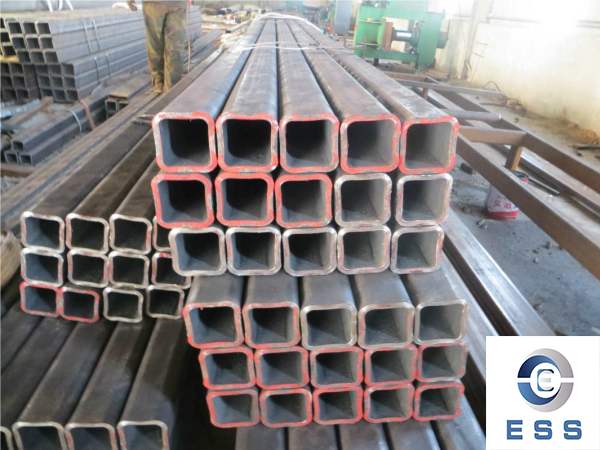The difference between cold rolling and hot rolling of ASTM A500 square tube
At present, ASTM A500 square tubes are rolled from billets. The main rolling methods are cold rolling and hot rolling, which will affect the structure and performance of the square tube to varying degrees.

1. Hot rolled ASTM A500 square tube
advantage:
It can destroy the casting structure of the steel pipe, refine the grains of the square pipe, and eliminate defects in the microstructure, thereby making the structure of the ASTM A500 square pipe dense and improving the mechanical properties of the steel pipe. This improvement is mainly reflected in the rolling direction, making ASTM A500 square tube no longer isotropic to a certain extent; bubbles, cracks, and pores formed during casting can also be welded under high temperature and high pressure.
shortcoming:
1. After hot rolling, the non-metallic inclusions (mainly sulfides and oxides, and silicates) inside the ASTM A500 square tube are pressed into thin sheets and layered. Delamination greatly deteriorates the tensile properties of the square tube in the thickness direction, and there is the possibility of interlayer tearing when the weld shrinks. The local strain caused by the shrinkage of the weld often reaches several times the yield point strain, which is much larger than the strain caused by the load;
2. Residual stress caused by uneven cooling. Residual stress is the internal self-balanced stress without external force. Such residual stress exists in hot-rolled steel sections of various cross-sections. In general, the larger the section size of the section steel, the greater the residual stress. Although residual stress is self-balancing, it still has a certain impact on the performance of steel components under the action of external forces. For example, it may adversely affect deformation, stability and fatigue resistance.
2. Cold rolled ASTM A500 square tube
It refers to processing steel plates or steel strips into various types of square tubes through cold processing such as cold drawing, cold bending, and normal temperature cold drawing.
advantage:
The forming speed is fast, the output is high, and the coating is not damaged. It can be made into a variety of cross-section forms to meet the needs of use conditions; Cold rolling can cause a large amount of plastic deformation in ASTM A500 square tubes, thereby increasing the yield point of ASTM A500 square tubes.
Disadvantages: 1. Although there is no thermoplastic compression during the molding process, there are still residual stresses in the cross section, which will inevitably affect the overall and local buckling characteristics of the ASTM A500 square tube;
2. The style of cold-rolled steel is generally a mountain-shaped section, which makes the free mechanical rotation stiffness of the section low. It is easy to rotate when bent, easy to twist and buckle when under pressure, and the torsional performance is poor;
3. The wall thickness of cold-rolled formed steel is small, the corners of plate connection are not thickened, and the ability to withstand local concentrated loads is weak.
The main differences between hot-rolled ASTM A500 square tube and cold-rolled ASTM A500 square tube are:
1. Cold-rolled section steel allows local buckling of the section, so that the bearing capacity of the component after buckling can be fully utilized; while hot-rolled section steel does not allow local buckling of the section.
2. The causes of residual stress in hot-rolled steel and cold-rolled steel are different, so the distribution on the cross-section is also very different. The residual stress distribution on the cold-formed thin-walled steel section is curved, while the residual stress distribution on the hot-rolled or welded steel section is film-like.
3. The free mechanical rotation stiffness of hot-rolled steel is higher than that of cold-rolled steel, so the torsion resistance of hot-rolled steel is better than that of cold-rolled steel.
Read more: What is square tube(SHS)? or What is the difference between square tube and rectangular tube?













 Eastern Steel Manufacturing Co.,Ltd not only improve product production and sales services, but also provide additional value-added services. As long as you need, we can complete your specific needs together.
Eastern Steel Manufacturing Co.,Ltd not only improve product production and sales services, but also provide additional value-added services. As long as you need, we can complete your specific needs together.










